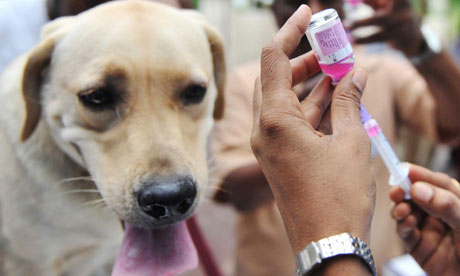
For those of us involved in the global battle to eliminate rabies, these past few years have been tumultuous.
There have been high points. In 2004, a Wisconsin schoolgirl, Jeanna Giese, became the first unvaccinated person to defeat the potentially life-threatening disease, giving real hope that the course of action to save her, known as the Milwaukee protocol, could lead to a lasting treatment.
There has been success in the developing world, too, where the disease is most prevalent. By working with government, educationalists and local communities, we have developed strategies for eliminating rabies at a local level for very little upfront investment.
But there have also been setbacks. The Milwaukee protocol (pdf), which involves putting the patient into a chemically induced coma to allow the body's immune system to gain strength, has had only sporadic success since our breakthrough with Jeanna. Despite the efforts of health professionals in the developing world, including those in my own organisation, the Global Alliance for Rabies Control, this clever, irrepressible killer continues to claim tens of thousands of lives every year.
Partly through complacency (many governments assume that once the disease has been brought under control, they can ignore it), lack of awareness and inadequate infrastructure, areas once considered rabies-free are again falling under its shadow. Countries such as Taiwan, which had been free from the disease for decades, and even France, which recently issued a rabies warning.
Yet there has never been a more optimistic time to be a rabies researcher. Those of us on the frontline can see a confluence of advances emerging that together may bring hope to the tens of millions of people affected by the disease each year.
One of our biggest problems is that because rabies tends to hit hardest in remote locations, it takes too long to learn of disease outbreaks. So we've been working hard with governments, universities, and other organisations to roll out enhanced surveillance, relevant diagnostic testing and improved infrastructure to address this.
The most cost-effective solution for controlling rabies is mass dog vaccination in at-risk communities. Not an easy task, given the huge numbers of stray dogs in many parts of the world. But advances in non-surgical contraceptives make it easier to manage canine populations without resorting to culling.
In the US, we've been working with the US department of agriculture, the Navajo nation, and the Mexican ministry of health on a combined, single-shot contraceptive and rabies vaccine that will bring further improvements in cost, efficacy and welfare.
And progress is being made in controlling the disease in other wild animals. Oral vaccines distributed in baits have helped control rabies in foxes, raccoons and coyotes. Ideas flourish as to how we can extend the treatment to mongooses, ferret badgers, marmosets and bats.
Too many people die because they either do not know about effective rabies treatment or cannot access it. In some cases, bite victims receive up to 21 shots over three to four weeks. When the nearest clinic is miles away, and treatment costs as much as it does, it is tragic but unsurprising that many people are not able to complete their course. Through more targeted drug delivery, we have reduced vaccination to two to three weeks and aim to cut it further, to just one week.
For the first time everything is aligned to prevent, control and eliminate rabies. There is a huge commitment at a global level and, most importantly, in local communities. Together we can defeat this killer.
Charles Rupprecht is director of research at the Global Alliance for Rabies Control

